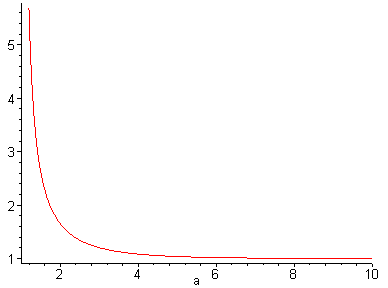Virtual Laboratories > Special Distributions > 1 2 3 4 5 6 7 8 9 10 [11] 12 13 14 15
The zeta distribution is used to model the size of certain types of objects randomly chosen from certain types of populations. Typical examples include the length of a word randomly chosen from a text, or the population of a city randomly chosen from a country. The zeta distribution is also known as the Zipf distribution, in honor of the American linguist George Zipf.
The Riemann zeta function, named after Bernhard Riemann, is defined as follows:
z(a) = ![]() n
= 1, 2, ... 1 / na. for a > 1.
n
= 1, 2, ... 1 / na. for a > 1.
(You might recall from calculus that the series in the zeta function
converges for a > 1 and diverges for a ![]() 1). A graph of the zeta function on the interval (1, 10) is given below:
1). A graph of the zeta function on the interval (1, 10) is given below:

![]() 1. Try
to verify the main properties of the graph analytically. In particular, show
that
1. Try
to verify the main properties of the graph analytically. In particular, show
that
The zeta function is transcendental, and most of its values must be approximated. However, z(a) can be given explicitly for even integer values of a; in particular,
z(2) = ![]() 2
/ 6, z(4) =
2
/ 6, z(4) = ![]() 4
/ 90.
4
/ 90.
![]() 2. Show that the the function f given below is
discrete
probability density function for any a > 1.
2. Show that the the function f given below is
discrete
probability density function for any a > 1.
f(n) = 1 / [na z(a)] for n = 1, 2, ...
The discrete distribution defined by the density function in Exercise 2 is called the zeta distribution with parameter a.
![]() 3.
Let X denote the length of a word chosen at random from a certain text,
and suppose that
X has the zeta distribution with parameter a = 2.
Find P(X > 4).
3.
Let X denote the length of a word chosen at random from a certain text,
and suppose that
X has the zeta distribution with parameter a = 2.
Find P(X > 4).
![]() 4. Suppose that X has the zeta distribution with parameter a. Show
that the distribution is a one-parameter exponential family with natural
parameter a and natural statistic -ln(X).
4. Suppose that X has the zeta distribution with parameter a. Show
that the distribution is a one-parameter exponential family with natural
parameter a and natural statistic -ln(X).
The moments of the zeta distribution can be expressed easily in terms of the zeta function.
![]() 5.
Suppose that X has the zeta distribution with parameter a > k
+ 1. Show that
5.
Suppose that X has the zeta distribution with parameter a > k
+ 1. Show that
E(Xk) = z(a - k) / z(a).
![]() 6.
In particular, show that
6.
In particular, show that
![]() 7. Let X denote the length of a word chosen at random from a
certain text, and suppose that X has the zeta distribution with parameter
a = 4. Find approximately
7. Let X denote the length of a word chosen at random from a
certain text, and suppose that X has the zeta distribution with parameter
a = 4. Find approximately